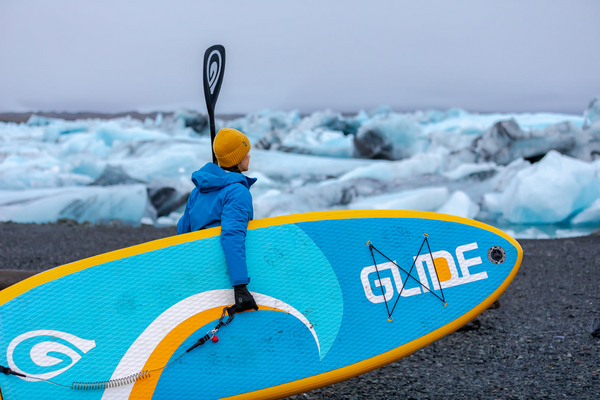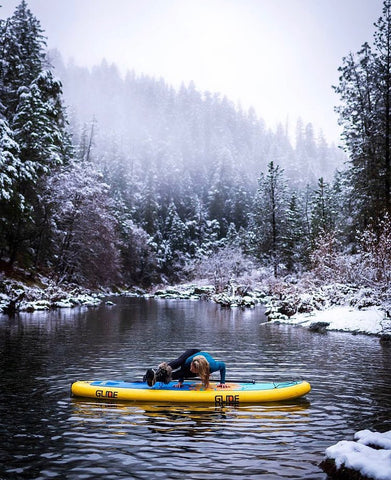
Winter is Coming
Winter brings a serene beauty to paddleboarding that Scott Knorp, co-owner of Glide Paddlesports, knows all too well. The crisp air, quiet waters, and the thrill of navigating through colder elements offer an invigorating SUP experience. Here, Scott shares his insights and tips for those daring enough to break out their SUPs in winter’s embrace.
There is much to love about breaking your SUP out in the wintertime: no crowds, invigorating air, and little chance of a sunburn. You will want to be properly prepared as we outlined in an earlier article this year. For me, the winter months are an exciting time to SUP because you can never be sure exactly what you are in for.

Key Highlights
- The Unique Allure of Winter Paddleboarding: Highlighting the peaceful, crowd-free experience and the invigorating challenge of colder conditions.
- Essential Preparations for Winter SUP: Outlining the importance of safety gear, waterproofing essentials, and appropriate wardrobe choices based on the 120-degree rule.
- Navigating Cold Waters Safely: Discussing the risks of hypothermia, the significance of wearing the right materials, and strategies for dealing with icy conditions and wind.
- Winter Paddleboarding Gear Recommendations: Recommending specific gear like neoprene booties and gloves, and emphasizing the importance of having a floating waterproof case for communication.
- Winter SUP Surfing Tips: Offering advice for those looking to ride the larger waves brought by winter storms, including wetsuit specifications.
- The Magic of Winter SUP: Sharing personal experiences that capture the stillness and beauty of paddleboarding in winter, and how it enhances the SUP experience.
The Allure of Winter Paddleboarding
Winter paddleboarding might not be for everyone, but for Scott, it’s an eagerly awaited season. The lack of crowds, the peaceful surroundings, and the slightly increased challenge make it uniquely rewarding. Of course, preparation is key to enjoying SUP in the colder months safely.
Essential Preparations:
- Safety Gear: A PFD (Personal Flotation Device) and a leash are non-negotiable, ensuring you stay safe and attached to your board.
- Waterproofing: Protecting your cell phone with a floating waterproof case is a smart move for emergency situations.
- Wardrobe Choices: The 120-degree rule is a good benchmark for deciding on a wet or dry suit. If the combined air and water temperature is below 120 degrees, suit up!
Navigating Cold Waters
Facing Hypothermia: Understanding the risk of hypothermia is crucial. Water cools the body much faster than air, making proper attire critical. If water temperatures hover around freezing, your survival time could be less than 45 minutes without protective gear.
Material Matters: Swap out cotton for moisture-wicking layers and insulating materials like wool, fleece, or Gore-Tex to keep warm and buoyant.

Paddleboarding Tactics in Winter
Adjusting for Ice: If waters are icing over, Scott opts for a dry suit and stays close to the shoreline for quick exits if needed.
Windy Conditions: Learning from experiences with kiteboarders, Scott advises knowing your limits with wind and preparing for the physical toll it can take.
Equipment Checks: Before venturing out, ensure your gear is in top condition—secure fins, intact paddles, and reliable PFDs are a must.

Gear for the Cold
Protecting Extremities: Neoprene wetsuit booties (5mm or 7mm) and gloves (1mm to 3mm) are essential for keeping fingers and toes warm.
Communication is Key: Keep your phone accessible and protected in a floating case like the Aqua Vault.
Strategy for Paddling: Start against the wind to expend more energy while you're fresh, allowing for an easier return with the wind at your back.

Winter SUP Surfing
For those drawn to the waves, a 5/4mm wetsuit with modern technology can keep you comfortable amidst the cold ocean swells. Winter storms often bring larger waves, offering thrilling conditions for SUP surfing.

The Magic of Winter Paddleboarding
Scott’s most cherished winter SUP moments come from the stillness of early mornings, with glassy waters reflecting snowy landscapes. A thermos of hot coffee never tasted so good as after a cold paddle session.
Closing Thoughts: For Scott and many others at Glide Paddlesports, SUP isn’t just a seasonal activity; it’s a year-round passion. With the right gear and precautions, winter paddleboarding can be a magical extension of your SUP adventures.
Related Topics
Things to Consider When Buying a SUP
Improving Fitness on Paddle Board
Can I Leave My Paddle Board Inflated?


